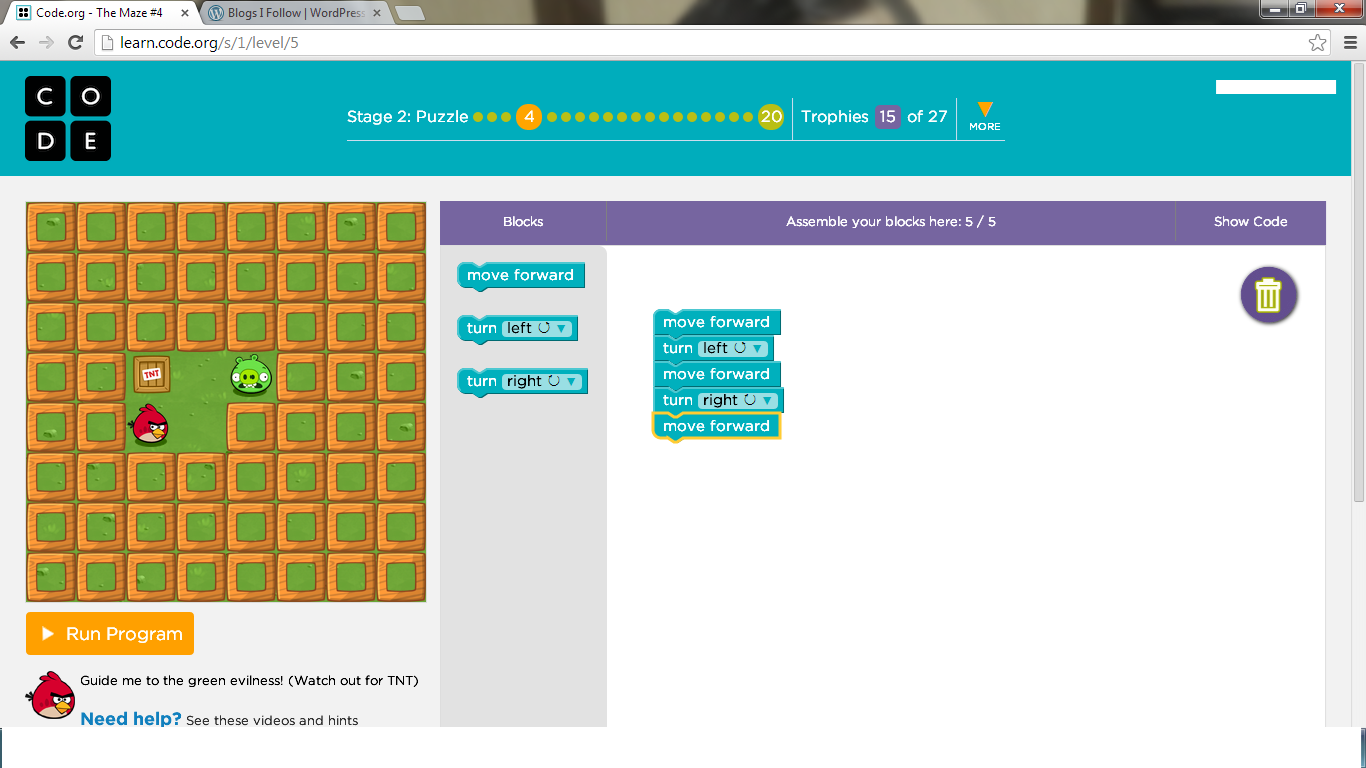Dots of connected numbers as learning instrument computational thinking concept in elementary school
DOI:
https://doi.org/10.71365/edujet.v1i1.1Keywords:
Computational Thinking, Elementary School, MathematicsAbstract
The skill needed by future generations when computers become more massive and more connected is to think like a computer. Computational thinking is a method of thinking commonly used by programmers when writing program code. There are four principles in computational thinking, (1) Decomposition, (2) Pattern Recognition, (3) Abstraction, and (4) Algorithm Design. The research was conducted in three stages: planning, development, and testing. The results obtained are that the dots of corresponding numbers can be a simple instrument to teach computational thinking but requires that children have mastered the sum operation. The four principles of computational thinking have been contained in the Dots of numbers connected.
References
Aho, A. V. (2012). Computation and Computational Thinking. The Computer Journal, 55(7), 832–835. https://doi.org/10.1093/comjnl/bxs074
Anistyasari, Y., Ekohariadi, & Kurniawan, A. (2018). Exploring Computational Thinking to Improve Energy-Efficient Programming Skills. MATEC Web of Conferences, 197, 4–7. https://doi.org/10.1051/matecconf/201819715011
Baratè, A., Ludovico, L. A., & Malchiodi, D. (2017). Fostering Computational Thinking in Primary School through a LEGO-based Music Notation. Procedia Computer Science, 112, 1334–1344. https://doi.org/10.1016/j.procs.2017.08.018
Bennett, N., Borg, W. R., & Gall, M. D. (1984). Educational Research: An Introduction. In British Journal of Educational Studies (Vol. 32, Issue 3, p. 274). https://doi.org/10.2307/3121583
Caeli, E. N., & Yadav, A. (2020). Unplugged Approaches to Computational Thinking: A Historical Perspective. TechTrends, 64(1), 29–36. https://doi.org/10.1007/s11528-019-00410-5
Chen, G., Shen, J., Barth-Cohen, L., Jiang, S., Huang, X., & Eltoukhy, M. (2017). Assessing Elementary Students' Computational Thinking in Everyday Reasoning and Robotics Programming. Computers & Education, 109, 162–175. https://doi.org/10.1016/j.compedu.2017.03.001
del Olmo-Muñoz, J., Cózar-Gutiérrez, R., & González-Calero, J. A. (2020). Computational Thinking Through Unplugged Activities in Early Years of Primary Education. Computers & Education, 150, 103832. https://doi.org/10.1016/j.compedu.2020.103832
Hershkovitz, A., Sitman, R., Israel-Fishelson, R., Eguíluz, A., Garaizar, P., & Guenaga, M. (2019). Creativity in the Acquisition of Computational Thinking. Interactive Learning Environments, 27(5–6), 628–644. https://doi.org/10.1080/10494820.2019.1610451
Hickmott, D., Prieto-Rodriguez, E., & Holmes, K. (2018). A Scoping Review of Studies on Computational Thinking in K–12 Mathematics Classrooms. Digital Experiences in Mathematics Education, 4(1), 48–69. https://doi.org/10.1007/s40751-017-0038-8
Kalelioğlu, F. (2015). A New Way of Teaching Programming Skills to K-12 Students: Code.org. Computers in Human Behavior, 52, 200–210. https://doi.org/10.1016/j.chb.2015.05.047
Kim, B., Kim, T., & Kim, J. (2013). Paper-and-Pencil Programming Strategy toward Computational Thinking for Non-Majors: Design Your Solution. Journal of Educational Computing Research, 49(4), 437–459. https://doi.org/10.2190/EC.49.4.b
Kules, B. (2016). Computational thinking is critical thinking: Connecting to university discourse, goals, and learning outcomes. Proceedings of the Association for Information Science and Technology, 53(1), 1–6. https://doi.org/10.1002/pra2.2016.14505301092
Kusnendar, J., & Prabawa, H. W. (2018). Using NCLab-Karel to Improve Computational Thinking Skill of Junior High School Students. Journal of Physics: Conference Series, 1013(1), 012104. https://doi.org/10.1088/1742-6596/1013/1/012104
Manabe, H., Tani, S., Kanemune, S., & Manabe, Y. (2018). Creating the Original Bebras Tasks by High School Students. Olympiads in Informatics, 12, 99–110. https://doi.org/10.15388/ioi.2018.08
Repenning, A., Webb, D., & Ioannidou, A. (2010). Scalable Game Design and The Development of a Checklist for Getting Computational Thinking into Public Schools. Proceedings of the 41st ACM Technical Symposium on Computer Science Education - SIGCSE '10, 265. https://doi.org/10.1145/1734263.1734357
Rodríguez del Rey, Y. A., Cawanga Cambinda, I. N., Deco, C., Bender, C., Avello‐Martínez, R., & Villalba‐Condori, K. O. (2020). Developing Computational Thinking with a Module of Solved Problems. Computer Applications in Engineering Education, November 2019, cae.22214. https://doi.org/10.1002/cae.22214
Rodríguez-Martínez, J. A., González-Calero, J. A., & Sáez-López, J. M. (2019). Computational Thinking and Mathematics Using Scratch: an Experiment with Sixth-Grade Students. Interactive Learning Environments, 0(0), 1–12. https://doi.org/10.1080/10494820.2019.1612448
Román-González, M., Pérez-González, J.-C., Moreno-León, J., & Robles, G. (2018). Can computational talent be detected? Predictive validity of the Computational Thinking Test. International Journal of Child-Computer Interaction, 18, 47–58. https://doi.org/10.1016/j.ijcci.2018.06.004
Tang, X., Yin, Y., Lin, Q., Hadad, R., & Zhai, X. (2020). Assessing computational thinking: A systematic review of empirical studies. Computers & Education, 148, 103798. https://doi.org/10.1016/j.compedu.2019.103798
Tran, Y. (2019). Computational Thinking Equity in Elementary Classrooms: What Third-Grade Students Know and Can Do. Journal of Educational Computing Research, 57(1), 3–31. https://doi.org/10.1177/0735633117743918
Varela, C., Rebollar, C., García, O., Bravo, E., & Bilbao, J. (2019). Skills in computational thinking of engineering students of the first school year. Heliyon, 5(11), e02820. https://doi.org/10.1016/j.heliyon.2019.e02820
Wing, J. M. (2014). Computational Thinking. In Computing Handbook, Third Edition (Vol. 49, Issue 3, pp. 1–20). Chapman and Hall/CRC. https://doi.org/10.1201/b16812-43
Wooster, J. S., & Papert, S. (1982). Mindstorms: Children, Computers, and Powerful Ideas. The English Journal, 71(8), 60. https://doi.org/10.2307/816450
Yadav, A., Hong, H., & Stephenson, C. (2016). Computational Thinking for All: Pedagogical Approaches to Embedding 21st Century Problem Solving in K-12 Classrooms. TechTrends, 60(6), 565–568. https://doi.org/10.1007/s11528-016-0087-7
Zhao, W., & Shute, V. J. (2019). Can playing a video game foster computational thinking skills? Computers & Education, 141(January), 103633. https://doi.org/10.1016/j.compedu.2019.103633

Downloads
Published
How to Cite
Issue
Section
License
Copyright (c) 2022 Edutechnium Journal of Educational Technology

This work is licensed under a Creative Commons Attribution-ShareAlike 4.0 International License.







